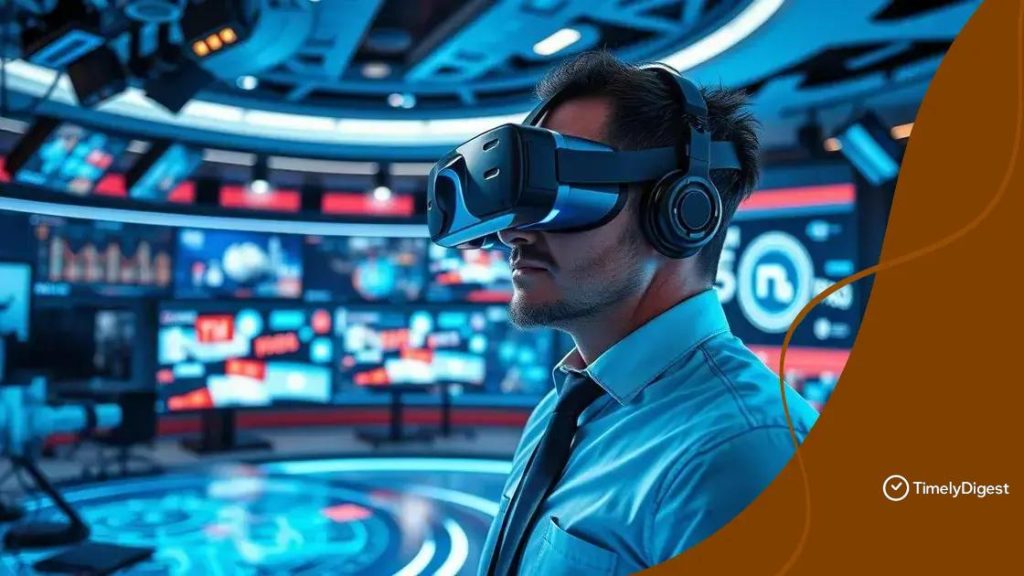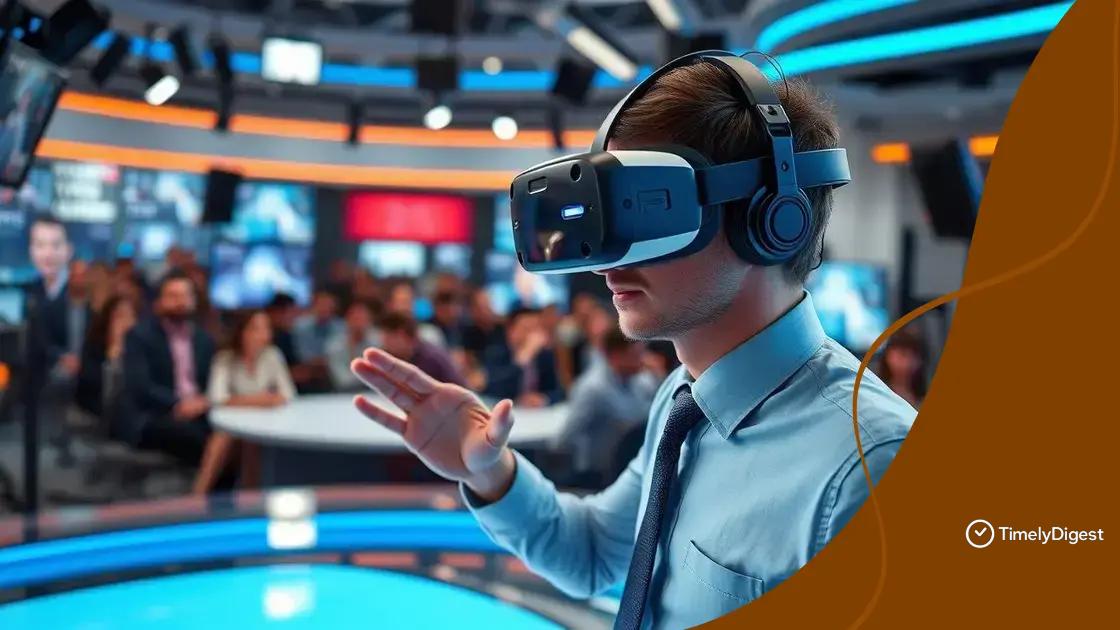Virtual reality in news reporting: immersive journalism experiences

Anúncios
Virtual reality in news reporting transforms storytelling by creating immersive experiences that engage viewers, allowing them to connect emotionally with the news in ways traditional media cannot.
Virtual reality in news reporting is changing how we consume information. Imagine being transported to the heart of breaking stories, feeling as if you are truly there. This article explores how this exciting technology reshapes journalism.
Anúncios
Understanding virtual reality in journalism
Understanding virtual reality in journalism is essential in today’s rapidly changing media landscape. This immersive technology is reshaping how stories are told and experienced.
With virtual reality, journalists can transport their audience into the midst of the action. This creates a sense of presence that traditional media often lack. Imagine watching a news report on a natural disaster and feeling as though you are right there, experiencing the chaos.
How Virtual Reality Works in Journalism
Virtual reality operates through advanced technology, combining 3D graphics, 360-degree video, and other tools to create immersive content. Users wear headsets that allow them to look around and interact with the environment.
Anúncios
Key Components
- Immersive storytelling: Engages the viewer by making them feel part of the story.
- Interactive features: Allow users to explore different perspectives and angles.
- Realistic simulations: Provide an authentic experience, enhancing understanding and empathy.
As technology advances, the use of virtual reality in journalism continues to evolve. News organizations are experimenting with its potential, finding new ways to inform and engage audiences. For example, experiencing a VR documentary about climate change can evoke emotions that traditional articles struggle to convey.
The challenges of integrating virtual reality into news reporting include high production costs and the need for specialized skills. However, the potential benefits far outweigh these hurdles. By embracing this technology, journalists could revolutionize the way information is shared and absorbed.
The technology behind immersive news experiences
The technology behind immersive news experiences is both fascinating and complex. Various tools and innovations work together to create a compelling narrative that engages viewers in unique ways.
At the core of this technology is virtual reality (VR), which allows journalists to present stories in 3D environments. This helps viewers feel as though they are part of the story. Moreover, 360-degree video plays a crucial role, enabling users to look around and explore every angle of a scene.
Key Technologies Used
To develop immersive news experiences, several key technologies come into play. Each contributes to the effectiveness of the storytelling:
- 360-Degree Cameras: These cameras capture every angle, creating a full view of the environment.
- VR Headsets: Devices like Oculus Rift or HTC Vive allow users to enter the immersive experience.
- Spatial Audio: This technology enhances realism by allowing sounds to come from different directions.
In addition to these, software platforms are vital for editing and producing immersive content. They enable journalists to weave together video, audio, and interactive elements into a cohesive story. One significant aspect of immersive journalism is its ability to evoke emotions, making stories more impactful.
Furthermore, advances in computing power and graphics technology have made these experiences more accessible. Journalists can now create high-quality content without massive budgets, reaching audiences in new ways. As this technology continues to evolve, so too will the methods for delivering news.
Benefits of virtual reality for reporters

The benefits of virtual reality for reporters are transforming the landscape of journalism. By using this innovative technology, journalists can tell stories in ways that engage audiences like never before.
One significant advantage is the improved storytelling potential. Virtual reality allows reporters to create immersive narratives that draw viewers in. This can lead to a deeper emotional connection with the subject matter, making the news more impactful.
Enhanced Audience Engagement
Another benefit is enhanced audience engagement. With immersive experiences, viewers can interact with the story environment. This leads to a greater understanding of complex issues, as they can see things from various perspectives.
Key Benefits
- Increased Empathy: Experiencing stories in VR helps audiences empathize with those affected by the news.
- Real-Time Reporting: Reporters can deliver live updates with immersive content, making the information more relevant.
- Expanded Reach: By adopting VR, news outlets can attract a wider audience, including tech-savvy younger generations.
Moreover, virtual reality can enhance the educational aspect of journalism. Reporters can provide in-depth coverage of significant events, helping audiences comprehend intricate situations better. This is particularly useful for coverage of events like natural disasters or conflicts, where the environment plays a critical role.
As the field of journalism evolves, so too do the tools at a reporter’s disposal. Embracing virtual reality opens the door to new possibilities, enriching the viewer’s experience and allowing stories to be told in transparent and engaging ways.
Challenges in adopting virtual reality in news
Challenges in adopting virtual reality in news reporting can be significant. While the technology offers exciting opportunities, there are several hurdles that news organizations must navigate.
One major challenge is the high cost of production. Virtual reality content requires specialized equipment and skilled personnel, which can strain budgets. This is especially difficult for smaller news outlets that may not have the resources to invest in such technologies.
Technical Limitations
Another obstacle is the technical complexities associated with virtual reality. Creating immersive experiences often involves more intricate production processes than traditional media. This can lead to longer development times and potential technical difficulties during broadcasts.
Audience Accessibility
Additionally, not all audiences have access to the required technology. While VR headsets are becoming more common, many people still rely on conventional devices. This can result in a limited audience for virtual reality news stories.
- Cost of Technology: The expense of equipment like cameras and editing software can be a barrier.
- Skill Gaps: Many journalists may not be trained in VR production, limiting the quality of content.
- Viewer Engagement: Audiences might not engage with VR content as expected, leading to lower viewership.
Furthermore, the fast pace of news means that materials must be timely. Incorporating virtual reality necessitates extra time for production, which can affect the immediacy of news reporting. Failing to keep up with regular reporting schedules can diminish the impact of stories tagged as VR experiences.
As virtual reality continues to develop, news organizations must find ways to overcome these challenges. By investing in training and exploring cost-effective solutions, they can better harness the potential of this innovative medium to enhance storytelling.
Future trends of virtual reality in journalism
Future trends of virtual reality in journalism are exciting and full of potential. As technology evolves, so does the way news is presented and consumed.
In the coming years, we are likely to see significant advancements in VR technology that will enhance the immersive experience for viewers. One promising area is the integration of artificial intelligence with virtual reality. AI can help tailor news content to individual preferences, making stories more personalized and engaging.
Enhanced Interactivity
The future of virtual reality in journalism also points toward increased interactivity. Viewers may soon be able to participate in the news experience actively. Imagine being able to ask questions or choose what aspect of a story to explore further while immersed in a virtual environment.
Broader Accessibility
Another trend is the push for broader accessibility. As VR devices become more affordable and widely available, more people will have access to immersive journalism. This could lead to a larger audience and, ultimately, a greater impact on public awareness and understanding of important issues.
- Seamless Integration: Expect integration of VR with live reporting, bringing real-time immersive experiences to the audience.
- Data Visualization: Complex data and statistics could be represented visually in immersive ways, making information easier to digest.
- Global Collaboration: Journalists across the world could collaborate on VR projects, sharing experiences and stories that transcend geographical barriers.
Furthermore, the use of 360-degree video will become even more refined, allowing for smoother transitions and richer details. This can create an even more realistic environment that draws viewers in and helps them connect with the story on a deeper level.
As virtual reality technology matures, news organizations must adapt to these trends. Embracing innovation will be key to staying relevant in a constantly evolving media landscape.
Conclusion: The future of virtual reality in journalism is bright and promising. As technology advances, news reporting will become more immersive and interactive, allowing audiences to engage with stories like never before. With the right tools and creativity, journalists can harness the power of VR to enhance storytelling and foster deeper connections with viewers. While challenges exist, the potential benefits of adopting virtual reality are immense. Embracing this innovative medium is essential for staying relevant in an ever-changing media landscape.
FAQ – Frequently Asked Questions about Virtual Reality in Journalism
What is the main benefit of using virtual reality in journalism?
The main benefit is enhanced storytelling that allows audiences to feel immersed in the news, creating deeper emotional connections.
What challenges do news outlets face when adopting virtual reality?
News outlets face challenges such as high production costs, technical complexities, and limited audience accessibility.
How will the integration of artificial intelligence affect virtual reality in journalism?
AI will tailor virtual reality experiences to individual viewer preferences, making content more engaging and personalized.
What are some future trends for virtual reality in journalism?
Future trends include increased interactivity, broader accessibility, and enhanced data visualization techniques.